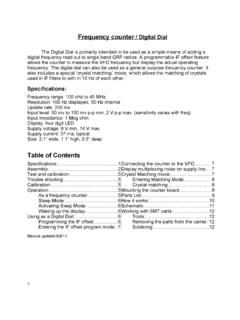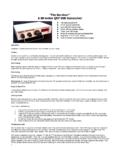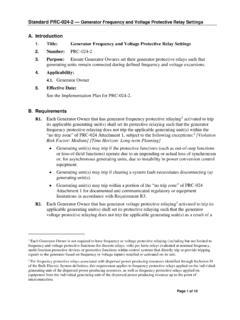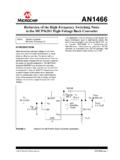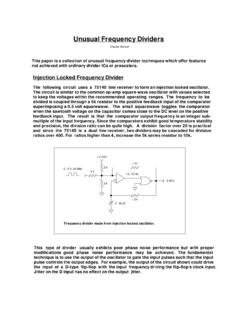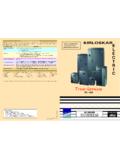Transcription of Frequency Counter / Digital Dial - QRP Kits - Pacific Antenna
1 Page 1 of 18 Frequency Counter / Digital Dial A KD1JV Melt Solder design Distributed by Hendricks QRP Kits Page 2 of 18 The Digital Dial is primarily intended to be used as a simple means of adding a Digital Frequency read out to single band QRP radios. A programmable IF offset feature allows the Counter to measure the VFO Frequency but display the actual operating Frequency . The Digital dial can also be used as a general purpose Frequency Counter . It also includes a special crystal matching mode, which allows the matching of crystals used in IF filters to within 10 Hz of each other. Specifications Frequency range: 100 kHz to 45 MHz Resolution: 100 Hz Update rate: 100 ms Input level: 50 mv p-p min, 2 V p-p max.
2 (sensitivity varies with freq) Input impedance: 1 Mega ohm. Display, four digit LED Supply voltage: 8 V min, 14 V max Supply current: 37 ma, typical Size: wide, high, deep Page 3 of 18 Table of Contents SPECIFICATIONS ..2 ASSEMBLY ..4 TEST AND TROUBLE SHOOTING ..7 OPERATION ..7 AS A Frequency SLEEP ACTIVATING SLEEP WAKING UP THE USING AS A Digital DIAL ..8 PROGRAMMING THE IF ENTERING THE IF OFFSET PROGRAM CONNECTING THE Counter TO THE VFO ..10 DISPLAY MULTIPLEXING NOISE ON SUPPLY LINE ..10 CRYSTAL MATCHING MODE ..10 ENTERING MATCHING CRYSTAL MOUNTING THE Counter PARTS LIST ..12 HOW IT WORKS.
3 13 WORKING WITH SMT REMOVING THE PARTS FROM THE Page 4 of 18 Assembly Empty the contents of the static bag into a soup or cereal bowl. This will help keep you from losing any of the small parts. In order to make identifying the SMT parts easier, some of the parts have been color coded. The colors indicated on the layout diagram corresponds to the color marked on the SMT carrier package. Only the 1 meg resistor has been color coded, so it isn;t mixed up with the 100K. In the case of capacitors and resistors, this marking was done with a color marker. So that you do not mix up the parts, work with only one type of parts at a time.
4 If there is more than one value used, place all of them before moving onto another. Surface mounted parts are installed first. All of these go on the back side of the board. If this is the first time you've assembled anything using SMT parts, please refer to the Building with SMT parts appendix at the end of the manual. Use .020 diam solder. Radio Shack carries it and it makes working with SMT parts much easier. Use these pictures to help locate and identify parts. Zoom in with the magnifier in the pdf viewer for a closer look. Note: U3 changed to ATTINT2313 and R5-12 to 1K Page 5 of 18 Recommended parts placement order shown in table: color location markings type quantity Q1 6T N.
5 J-fet 1 Q2 3C f NPN 1 BLUE C1 to 6 None, tan uFd cap 6 ORANGE C7 None, tan 22 pFd cap 1 R5 to 12 102 1 K 8 Yellow R1 105 1 Meg 1 R2 222 1 R3 104 100K 1 R4 1021K 1 BLACK L1 None, black uHy 1 D1 S2 49 Diode 1 U1 74HC4017 Counter 1 U2 ATTiny2313 MPU 1 U3 8C3M 5V reg 1 Page 6 of 18 Display: The display is soldered into place first. It requires a little rework before this can be done. The pins need to be bent out at a 90 angle to the body. Simply fold them over with your thumb or needle nose pliers, making the bend as close to the body of the display as possible. Once they are all bent over, clip them back about half their length, so that the pins do not go beyond the edge of the pads on the board.
6 Now the display can be soldered to the pads on the board. Be sure to orientate the display properly. The lettering on the display with the part number (LTC-4627) is on the side which faces towards C9 X1 S1. Also note the row of decimal points are along this bottom edge. Solder one corner pin first, then square up the display to the board. Solder the opposite corner pin. Double check to see that the display is square to the board and you have it installed properly. If it is up side down, its real hard to remove and fix once all the pins are soldered and the other parts installed! Once the display is soldered into place, proceed with the four remaining through hole parts.
7 C9 Green trimmer C8 47 uF/ 16V Long lead + X1 MHz crystal S1 TACT switch Assembly of the Counter is now complete. Now is a good time to inspect your workmanship and look for any solder connections you might have missed making. Look closely at both ends of the chip resistors and capacitors. Page 7 of 18 Test and calibration Connect up a power supply, a 9 V battery will do for now. When power is applied, the display should light up with four eights and four decimal points for a couple of seconds. [ ] This is the display test. Once the display test is over, the Counter will be in the kHz Frequency Counter mode. Due to stray pick up by the high impedance input, you will see random numbers flickering on the display.
8 Short the [SIG IN] terminals and the display should now read all zeros. [ ] Confirm Mode switch operation by clicking and verify display changes to MHz range [ ] Clicking and holding closed the Mode switch for one second should turn off the display. Clicking again turns the display back on. Trouble shooting There isn't a whole lot which can go wrong with this board. If it does not work first time, there is a chance the problem is with the soldering of parts. Therefore, this is what you need to look for first. The other .001% is a misplaced part. Calibration: The Counter needs to be calibrated before it will measure accurately. This is done by adjusting the green trimmer on the front of the board.
9 An accurate signal source is required and should be done at the highest Frequency available, which is in the range of the Counter (45 MHz). For most of you, the most accurate signal source you may have available is your commercial Big Rig , and the highest Frequency available will be in the 10 M band. The Counter is sensitive enough that making a pick up loop of a few turns of wire around the coax connecting the rig to a dummy load should work. In CW mode, most rigs transmit on the Frequency indicated by the dial, but this is not always the case. Sometimes, the Frequency transmitted will be 600 Hz lower than the dial reading. The rigs manual may indicate if this is the case, or you might have to verify it with a commercial Counter .
10 Operation The Digital dial is controlled by a single switch, which we will call the Mode switch. This switch may have more than one function, depending on the mode in which the Digital dial is being used. As a Frequency Counter The first time power is applied to the Digital dial, it will power up in the Frequency Counter mode. Since the Counter can count up to 45 MHz and there are only four digits of display, there is a display shift function. On power up, the kHz and 100 Hz digits are displayed. This is indicated by the decimal point being to the right of the third digit. The most significant digit is indicating 100 kHz and the least significant digit is indicating 100 Hz, or.


